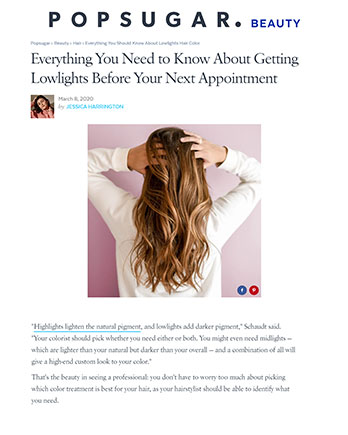Popsugar.com March 8, 2020
 Popsugar.com
Popsugar.com
Beauty
Everything You Need to Know About Getting Lowlights Before Your Next Appointment
Lowlights, highlights, single process, double process, balayage, ombré — there are a lot of hair-color terms to keep track of. For the sake of not sounding like a hair novice — and most importantly not ending up with something you don't want — at your next color appointment, we're taking it upon ourselves to share all the terminology and ins and outs of the treatments. This includes everything you should know before getting lowlights for the first time.
"Lowlights are when color is deposited back into hair that needs depth or contrast," said Karissa Schaudt, colorist at Maxine Salon in Chicago. Hair can become flat-looking, too light, or too brassy for a number of reasons, and lowlights are a great way to fix that.
Check out some lowlights inspiration, plus the answers to all your burning hair-color questions, ahead.
What's the Difference Between Lowlights and Highlights?
"Highlights lighten the natural pigment, and lowlights add darker pigment," Schaudt said. "Your colorist should pick whether you need either or both. You might even need midlights — which are lighter than your natural but darker than your overall — and a combination of all will give a high-end custom look to your color."
That's the beauty in seeing a professional: you don't have to worry too much about picking which color treatment is best for your hair, as your hairstylist should be able to identify what you need.
What Is the Color Process Like For Getting Lowlights?
Your stylist will either use foils or balayage to give you lowlights using a demipermanent color. Where your stylist puts the color will determine the look. "My preference is to highlight around the face by keeping the lowlights in the crown and underneath sections," Schaudt said.
What Is the Maintenance For Lowlights?
Like any hair-color treatment, there is a bit of maintenance involved to keep the style looking its best. In addition to using a color-safe shampoo, Schaudt recommended you not wash your hair more than three times a week. "If you're a regular highlight client, you may not need lowlights each appointment, but consult with your colorist to make that decision," she said.
Do Lowlights Work on All Hair Colors, Textures, and Types?
In short: yes, they work with a majority of hairstyles. Lowlights can help enhance your hair in different ways, depending on your natural hair texture and type, like "creating a thicker appearance on finer-hair clients, or adding dimensional qualities with textured clients," Schaudt said.
How to Decide Whether You Should Get Lowlights
When in doubt on anything hair related — color, cut, style, or other — always ask a professional. Come prepared with photos and inspiration on the final look you're aiming for. A quick chat with your colorist can help you determine the best approach to getting the hairstyle you want.
Find more lowlight inspiration ahead.
